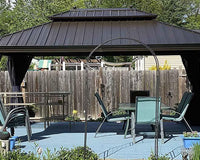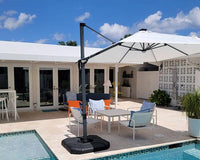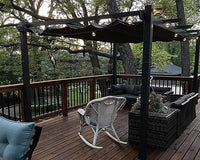Picking the perfect patio umbrella isn't just about colors and designs - it's all about getting the size right. Too big, and it swamps your space; too small, and you're squinting in the sun. In this guide, we'll tell you how to measure your space, match an umbrella to your table, and pick a stand that won't tip over. No matter if your outdoor area is snug or spacious, here are tips to help you find the ideal umbrella so you can kick back and relax with just the right amount of shade.
Umbrella Sizes
Before you can choose your patio umbrella, it’s important to understand the different sizes available and how they fit into your outdoor space.
Standard Patio Umbrella Sizes
There are a few common sizes that most patio umbrellas fall into:
- Small (6 to 7.5 feet): These umbrellas are best for compact spaces like small balconies or café-style tables meant for two.
- Medium (8 to 9 feet): These work well for standard patio tables that seat four to six people.
- Large (10 to 11 feet): Ideal for larger patio tables or poolside areas that accommodate up to eight people.
- Extra-Large (12 feet or more): These umbrellas provide maximum coverage for gatherings or oversized outdoor furniture sets.
How to Measure Your Space
To make sure you get a size that fits, you’ll need to measure your space. Here’s how to do it step by step:
- Clear the Area: Remove any items that might get in the way of your measurements.
- Measure the Width and Length: Using a tape measure, find the width and length of the area you want to shade.
- Consider Extra Space: Remember, you'll want your umbrella to extend over your dining or seating area by at least 2 feet on each side for adequate shade.
Sun Angle and Shade Coverage
The sun doesn’t stay put, and neither does the shade. As the sun moves, the area shaded by your umbrella will shift too. So, think about:
- Time of Day: When do you use your patio the most? The angle of the sun during your prime patio hours affects where the shadow falls.
- Umbrella Tilt: Some umbrellas tilt to help block the sun as its position changes. If yours does, you might not need as wide an umbrella.

Pairing Your Umbrella with the Perfect Table
Once you've got a handle on the different umbrella sizes, it's time to match one to your patio table. The right fit means everyone sitting down gets an equal share of shade without any awkward crowding.
Umbrella Sizes for Every Table Shape
When selecting umbrellas for various table shapes, the key is to ensure ample overhang. For round tables, an umbrella should surpass the table's diameter by at least 4 feet in total, providing 2 feet of shade around the perimeter. Square tables require a similar approach; choose an umbrella that stretches at least 2 feet beyond each side of the table—so an 8x8 foot umbrella would suit a 4x4 foot table seamlessly. Rectangular tables call for a more tailored fit, with the umbrella extending past the table's longest sides by 2 feet; for instance, a 6x4 foot table is well-matched with a 10x8 foot umbrella, ensuring complete coverage and comfort.
Adequate Coverage for Comfort
To make sure everyone enjoys the cool shade:
- Center It: The umbrella should be centered over the table to distribute shade evenly.
- Height Matters: Make sure the umbrella is tall enough for guests to sit and stand comfortably—typically 7 feet or higher from the ground to the underside of the canopy.
- Leave Room to Move: There should be enough space around the table so chairs can be pulled out without bumping into the base or the umbrella pole.
By considering both the size of your table and these additional tips, you'll create an inviting outdoor dining or lounging area where everyone can relax out of the sun's glare.

How to Choose a Solid Umbrella Foundation: Bases and Stands
Securing your patio umbrella with the right stand and base is a safety issue. An appropriate base ensures that your umbrella doesn’t take flight at the first gust of wind.
Selecting the Right Base Weight
The weight of your base will depend on how large your umbrella is.
- Below 7.5 Feet: A base weight of 20 to 30 pounds should be sufficient for the smaller umbrellas.
- Between 7.5 and 9 Feet: You want a base weighing between 30 to 40 pounds.
- Between 9 and 11 Feet: Get a base that's at least 50 pounds.
- Over 11 Feet: You most likely will want a base over 70 pounds or a permanent mount.
These weights are general guidelines for normal conditions.
If you live in a very windy area or you have an umbrella with a high profile, like a cantilever design, then you will need a heavier base. Cantilever parasols, with their unique side-post design, demand a more robust base weight to maintain balance and ensure safety. The off-center weight distribution of these parasols requires you to consider the following guidelines when selecting a base:
- Below 8 Feet: A base weight of 70 to 90 pounds should suffice for smaller cantilever umbrellas, providing the necessary counterbalance.
- Between 8 and 9 Feet: For umbrellas of this size, a heftier base weighing between 200 to 220 pounds is recommended to offset the leverage effect of the umbrella.
- Between 9 and 11 Feet: Such expansive shades require substantial support, so a base that weighs at least 280 pounds is essential to anchor the structure securely.
- Over 11 Feet: The largest cantilever parasols need even greater stability. Here, you'll want a base that exceeds 330 pounds or to opt for a permanent mounting solution to ensure that your umbrella can withstand various conditions without toppling.
Ensuring Stability and Safety
First, check if the diameter of your umbrella pole would fit perfectly in the base. A mismatched base would indeed result in a wobbly setup. While investing in a stand of good quality that is sturdy may require more money upfront, it saves you a lot in the long run by providing critical stability to your umbrella and, as such, gives it long years of service. Also, in case you feel you'll be moving your shade provider too frequently, opt for a base fitted with handles or wheels. This allows convenience in mobility without compromising the safety and functionality aspects.
Special Umbrella Sizing for Unique Spaces
Whether you have an irregularly shaped area or specific features to accommodate, let's look at how to tailor your shade solution.
Tailoring to Uniquely Shaped Patios
Application of custom shade approaches should be applied for patios that are designed multi-level, angled, curvy, or simply narrow in dimensions. Address the multi-levels by creating each area as its own space, choosing umbrella sizes that complement the dimensions of each specific level rather than trying to take care of the whole space with one huge shade. Where there are corners or curves in spots, you will be much better off with several smaller umbrellas that provide more effective coverage than a single large one. On narrow balconies where space is at a premium, half-umbrellas or wall-mounted ones provide enough shade without eating into the precious outdoor space.
Accounting for Features and Accessories
Your patio umbrella needs to work around more than just the shape of your space. Keep in mind:
- Built-In Seating: Make sure the umbrella can clear any fixed benches or structures. A tilting umbrella might be necessary here.
- Fire Pits and Heaters: Choose an umbrella that is large enough to provide shade but not so large that it poses a fire risk when used near heat sources.
- Pools and Water Features: Go with umbrellas that have rust-resistant poles and hardware, especially in chlorinated environments.

Final Thoughts on Patio Umbrellas
For getting the quintessential patio umbrella, size does matter. Measurement of the space, the trajectory of the sun, matching of the umbrella to the table, and choice of a sturdy base—each step is important in piecing together a serene, stylish outdoor retreat. Customization for specific layouts and mindful material selection further refine your shaded retreat. With these considerations harmoniously tackled, you could pick an umbrella that will not only complement your outdoor decor but also make it your haven—a place where leisure and functionality are shaded by nothing less than perfection.





1 comment
Pat Blum
I have received an 11 foot round navy cantilever umbrella from Amazon. However, I am in need of the corresponding base which was not in the order that was placed. I would like to purchase directly from you and also a navy cover to protect the umbrella for 11 foot round can you help me